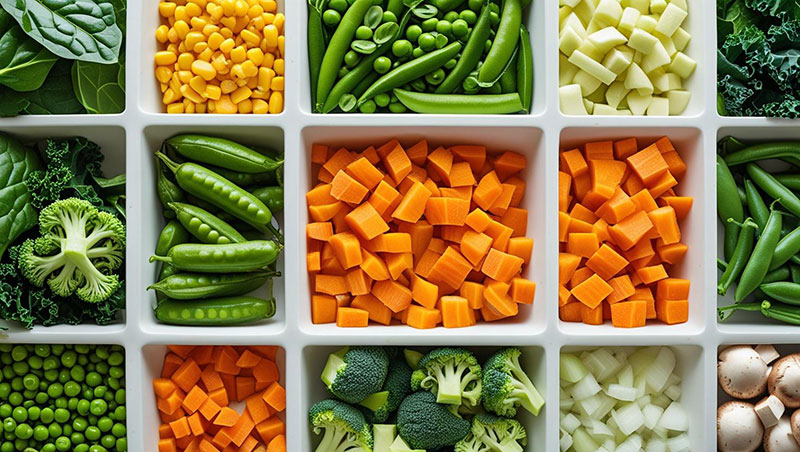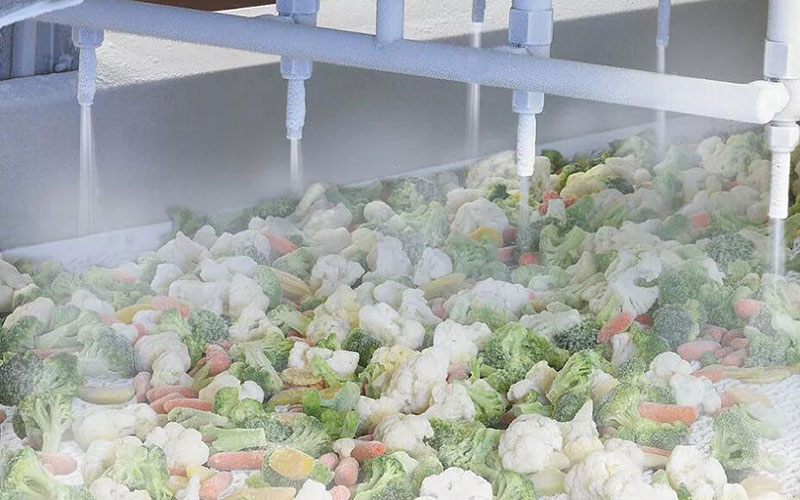A vegetable IQF freezer is a high-performance industrial machine that freezes vegetables individually at extremely low temperatures (typically -30°C to -40°C) within minutes. Unlike block or bulk freezing, each piece of vegetable remains free-flowing, which ensures easy portion control, better texture, and faster defrosting.
IQF freezers are widely used to freeze:
- Leafy greens (spinach, kale)
- Diced carrots, peas, sweet corn
- Green beans, okra, broccoli florets
- Mushrooms, zucchini, onions, and more

How the Vegetable IQF Freezing Process Works
The IQF process is a combination of advanced airflow technology and rapid cooling:
Lavado & Blanching → Pre-Cooling → IQF Freezing Tunnel → Packaging & Storage
- Step 1: Pre-treatment – Vegetables are washed diced or chopped and blanched to deactivate enzymes.
- Step 2: Pre-cooling – Vegetables are cooled to prepare for rapid freezing.
- Step 3: IQF Freezing – In the IQF freezer, vegetables pass through a freezing tunnel on a conveyor belt while being exposed to high-velocity cold air.
- Step 4: Packaging – The frozen vegetables are then packaged in bulk or retail-ready bags.
This process helps lock in color, sabor, texture, and nutritional value better than any other method.
Using a Vegetable IQF Freezer Advantages
Investing in an IQF freezer brings significant benefits to food processors and exporters:
✅ Individual Freezing
Each piece of vegetable is frozen separately—ideal for ready meals, retail bags, or foodservice operations.
✅ Fast Freezing Time
Minimizes the formation of large ice crystals, preserving cell structure and mouthfeel.
✅ High Throughput
Modern vegetable IQF freezers can handle 500kg/h to 5000kg/h, suitable for all scales of operation.
✅ Versatile Applications
Suitable for mixed vegetables, stir-fry blends, organic produce, and export-grade packs.
✅ Longer Shelf Life
Frozen vegetables can be stored for up to 18 months without losing quality.

Choosing the Right Vegetable IQF Freezer
When selecting a vegetable IQF freezer, consider the following factors:
| Feature | Description |
|---|---|
| Freezing Capacity | Choose based on your daily processing needs. |
| Footprint & Design | Tunnel length and height should match your plant layout. |
| Energy Efficiency | Look for models with advanced insulation and refrigerant control. |
| Cleaning System | Automatic CIP (Clean-In-Place) systems save time and labor. |
| Customization | Multi-zone temperature control for different vegetable types. |
Applications in the Frozen Vegetable Industry
Vegetable IQF freezers are widely used in:
- Frozen food manufacturing plants
- Export processing zones
- Supermarket supplier networks
- Institutional food service providers
- Contract packers for private labels
If your business aims to meet the rising global demand for convenient and healthy frozen vegetables, a vegetable IQF freezer is no longer optional—it’s a necessity.
Final Thoughts
The vegetable freezing process has transformed over the years, y IQF freezing now leads the way in quality, efficiency, and product appeal. By investing in a vegetable IQF freezer, food processing companies can achieve consistent results, minimize waste, and offer premium frozen vegetables to both local and global markets.
Interested in learning more about the best vegetable IQF freezer options for your business? Contact us now for expert advice, tailored configurations, and competitive pricing.




